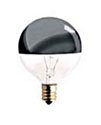mathjak107
Give me a museum and I'll fill it. (Picasso) Give me a forum ...
- Joined
- Jul 27, 2005
- Messages
- 6,208
dont confuse watts consumed with lumen output on lamps they are very different. when we say a lamp is 100watt or 75 watt we are referring to the power consumed , it has nothing to do with the light output and for how long.
the cheapie compacts are really not all that efficiant when you take the reduced light output they give vs the greater lumen output for the more expensive cfl...... also most important, flourescent lamps get dimmer and dimmer starting the moment you throw the light switch. so much so they can loose 60% of their light output towards the end of the lamp life.
this gradual getting dimmer and dimmer is not a spec you can look at.
see how lamp life is rated. usually its the point where 1/2 the lamps tested burned out. dosnt mean you will ever get anywhere near that point .
how many hours on and off do they test these lamps? manufacturers can rate a lamp for as many hours as they want by playing with the on off cycles.
point is if you truly want to save money dont buy these crappie chinese imports.
the cheapie compacts are really not all that efficiant when you take the reduced light output they give vs the greater lumen output for the more expensive cfl...... also most important, flourescent lamps get dimmer and dimmer starting the moment you throw the light switch. so much so they can loose 60% of their light output towards the end of the lamp life.
this gradual getting dimmer and dimmer is not a spec you can look at.
see how lamp life is rated. usually its the point where 1/2 the lamps tested burned out. dosnt mean you will ever get anywhere near that point .
how many hours on and off do they test these lamps? manufacturers can rate a lamp for as many hours as they want by playing with the on off cycles.
point is if you truly want to save money dont buy these crappie chinese imports.

 Turned out to be a waste of time, actually I was going to the landfill anyway. When I asked the landfill attendant where I should dispose of the fluorescent bulb, she said just throw it in the dumpster with the rest of the trash.
Turned out to be a waste of time, actually I was going to the landfill anyway. When I asked the landfill attendant where I should dispose of the fluorescent bulb, she said just throw it in the dumpster with the rest of the trash. 
